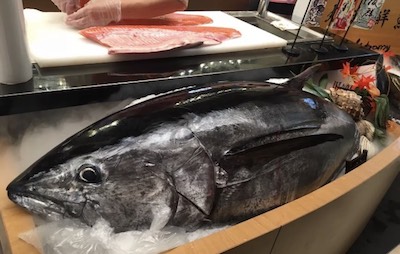We are reader supported. When you purchase through links on our site, we may earn an affiliate commission. Also, as an Amazon affiliate, we earn from qualifying purchases.

Sushi is a Japanese entrée made-up of small rolls of vinegar-flavored, cold, pre-cooked rice and served with raw fish and vegetables. It is highly popular in the East and gaining popularity at a rapid rate in the West. For sushi to be at its best, it needs to be made from fresh, high-quality ingredients, especially the fish. Let’s explore in more detail what sushi-grade fish is and why it is the only choice for sushi lovers.
What is sushi grade tuna? Sushi grade tuna is the freshest, highest quality tuna you can buy and is best for eating raw. Sushi-grade tuna is inspected and graded by wholesalers prior to being sold at the grocery store. The best fish is assigned a Grade 1 rating, which is then marketed as sushi grade.
Contents
Sushi Tuna Types
The most common types of tuna used for making sushi include the following:
- Bluefin tuna. Bluefin is caught in the Atlantic Ocean. It is a top-choice for sushi restaurants worldwide because of its unique flavor profile. The fat and protein in this fish are perfectly balanced and the pieces have a melt-in-your-mouth sensation!
- Yellowfin tuna. Yellowfin tuna (or Ahi tuna) is most commonly used for sushi in Japan. It is a good choice because it can be eaten raw and is easy to purchase at your local grocery store or fish market. It is pale-pink in color with a flavor similar to albacore tuna.
- Bigeye tuna. Bigeye tuna (another type of Ahi tuna) is found in the deep waters of the tropical Atlantic and the western Indian Ocean. It has a high-fat content with marbling near the skin and a richer flavor, fuller mouthfeel than other types of sushi.
- Albacore tuna. Albacore tuna is a great choice for sushi. It has a milder taste and firmer texture than other tuna types and is considered safe to eat raw. It is easily accessible at your local grocery store and quite reasonably priced.
Which Tuna is Sushi Grade?
Sushi grade tuna is any type (like the ones listed above) that meets a specific standard of quality and freshness. This classification includes fish that has been flash-frozen at sea, immediately after being caught, and kept at below-freezing temperature until sold at retail.
In the United States and Canada, national food safety regulations require that tuna used for raw consumption by humans be frozen and kept at a specific temperature in order to kill any parasites or parasite larvae. Tuna that is flash-frozen and kept at below freezing temperatures will meet this regulatory food safety requirement for quality and freshness.
Sushi grade tuna is frozen solid when it is sold in a wholesale market. Core samples are taken by punching a tube-like tool into the fish, usually near the tail, gills or head, in order to ascertain the quality of the meat.
After being sold, the tuna will be cut into blocks (using a band saw) for intermediate wholesalers, who will then cut the large chunks into smaller ones for the retailer. These chunks are then thawed-out for the first time since the fish was caught and frozen.
The average consumer evaluations for fish freshness do not apply, as sushi-quality tuna will not reach a consumer whole (with skin and eyes still intact). Instead, check for small, saw-cut pieces of the best part of the fish, preferably still in the mostly frozen state. It will have no odor at all and there will no fat, bones or connective tissue of any kind.
Where Can I Buy Sushi Grade Fish?
Sushi Grade fish, including tuna, is available for purchase at the following:
- On-line fish markets. There are many online companies that sell sushi grade fish, including tuna. Examples of these include the Honolulu Fish Company, the Seattle Fish Company, and Catalina Offshore Products. Top chefs around the world (who simply will not settle for frozen fish or local grocery store fish fillets) choose online sites to purchase their sushi grade fish.
- Japanese Markets. If you are fortunate enough to have one near you, these are generally considered good places to buy sushi-grade fish. They sell a variety of fish, including tuna, and the portions have usually been cut into ready-to-make sushi pieces already.
- Fishmonger or Grocery Store. While it is possible to find sushi-grade fish (tuna) at a grocery store (or fishmonger) it is not necessarily safe to just assume so. It is recommended that you talk to the local fishmonger and ask if they do indeed sell sushi-grade fish.
Is It Safe to Eat Raw Fish?
While the idea of eating raw, fresh-caught fish from the ocean sounds good to sushi lovers, this may pose a risk to one’s health. Tuna, unlike other sushi-type fish, is often considered safe to eat raw without freezing first. However, the only way to be sure that tuna is safe, meaning free of parasite or parasite larvae, is to freeze the meat prior to consumption.
How to Prepare Sushi Grade Fish

When using sushi grade tuna like this there is no need to cook beforehand. All you need is a knife and the following instructions:
- Remove the skin first. Do this by inserting a boning knife like this at the tail-end of the fish and grabbing the flap of skin, pulling the skin to the left while slicing to the right. Cut the tail portion off and either save for cooking later or discard.
- Cut out the white line running down the center of the fish, which is unpleasantly chewy and should not be eaten raw.
- Set the belly aside and slice the flesh away from both sides to separate the row of pin bones.
- Remove the bloodline in the middle portion of the fish. You now have three saku blocks – pieces of fish divided into sections based on the direction of the grain.
- Gather all necessary tools (bamboo mat or tea towel for rolling) and ingredients (roasted seaweed sheets, cold cooked vinegar-flavored rice, vegetables, soy sauce, wasabi, etc.) and make the sushi. This is the fun part!
How to Cure Fish for Sushi
Sometimes referred to as the ‘sushi-chef secret’, cured fish is a great way to add flavor to sushi, by seasoning the seafood beforehand. This is the secret to that deliciously firm, vibrant colored and full-of-flavor fish that great chefs love! And all you need is three simple ingredients: salt, sugar and fish.
To cure fish (like tuna) for sushi, follow these simple steps:
- Freeze fish beforehand for at least seventy-two hours to kill any parasites in the meat and let thaw in the refrigerator. If the fish is sushi-grade, no need to freeze.
- Prepare the ‘cure’ mixture which consists of salt and sugar. The ratio is three parts of cane sugar to one part of sea salt.
- Place fish on a sheet pan, cover completely with the cure mixture.
- Add some lemon zest – optional, but will give the meat additional flavor.
- Let the fish sit for at least one hour. You will know it is ready when the water from the meat comes out and changes color from orange to reddish-orange.
- Rinse the mixture off of the fish with water and allow it to dry completely.
- Cut the fish into sushi-sized portions.
- Place the fish back into the refrigerator until ready for use.
Related Questions
What is the difference between ‘sushi grade’ and ‘sashimi grade’ fish?
Sushi grade and sashimi grade are terms used interchangeably to classify types of fish deemed ‘safe’ for raw consumption. They represent the freshest and highest-quality fish the online retailer, fish market or grocery store has to offer.
Related Article: Difference Between Nigiri, Sashimi, Sushi Roll, Hand Roll, Gunkan Sushi
Can I eat raw tuna from the grocery store?
Tuna is a fish often considered ‘safe’ to eat raw, especially if it is marked ‘sushi grade’. Be cautious when buying tuna from a grocery store for sushi, as the fish is only as safe as its handler. In other words, if the fishmonger is storing unwrapped sushi-grade tuna in the same refrigerator as non-sushi grade fish, this could affect the quality and freshness of the meat.
What kind of tuna is used for sashimi?
Bigeye and yellowfin tuna are the most commonly used types for sashimi sushi. The belly (in particular the lower portion) is the best part to use, as it is rich in fat and has a melt-in-your-mouth feel.
Conclusion
In conclusion, sushi grade fish is of the freshest, highest quality available on the market today. Although there are no specific federal guidelines in place to determine if a fish is sushi-grade, the FDA (Food Drug Administration) does regulate the safe handling procedures for fish used for raw consumption.
Although sushi grade fish (including tuna) is considered ‘safe’ to eat raw, it is still the consumer’s responsibility to be diligent in both the handling and preparation of the fish. Parasite infections and bacterial contamination are possible with raw fish, which is why it is recommended it be frozen first.
If you know what to look for in fresh fish, then your choice to eat raw meat is determined only by your comfort (and risk) level. Otherwise, choosing sushi grade tuna is your best (and likely safest) bet. Now, ‘Itadakimasu’ (bon apetit)!

